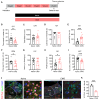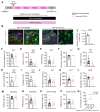Neuronal TCF7L2 in Lateral Habenula Is Involved in Stress-Induced Depression
- PMID: 39596468
- PMCID: PMC11594340
- DOI: 10.3390/ijms252212404
Neuronal TCF7L2 in Lateral Habenula Is Involved in Stress-Induced Depression
Abstract
Depression is a complex psychiatric disorder that has substantial implications for public health. The lateral habenula (LHb), a vital brain structure involved in mood regulation, and the N-methyl-D-aspartate receptor (NMDAR) within this structure are known to be associated with depressive behaviors. Recent research has identified transcription factor 7-like 2 (TCF7L2) as a crucial transcription factor in the Wnt signaling pathway, influencing diverse neuropsychiatric processes. In this study, we explore the role of TCF7L2 in the LHb and its effect on depressive-like behaviors in mice. By using behavioral tests, AAV-mediated gene knockdown or overexpression, and pharmacological interventions, we investigated the effects of alterations in TCF7L2 expression in the LHb. Our results indicate that TCF7L2 expression is reduced in neurons within the LHb of male ICR mice exposed to chronic mild stress (CMS), and neuron-specific knockdown of TCF7L2 in LHb neurons leads to notable antidepressant activity, as evidenced by reduced immobility time in the tail suspension test (TST) and forced swimming test (FST). Conversely, the overexpression of TCF7L2 in LHb neurons induces depressive behaviors. Furthermore, the administration of the NMDAR agonist NMDA reversed the antidepressant activity of TCF7L2 knockdown, and the NMDAR antagonist memantine alleviated the depressive behaviors induced by TCF7L2 overexpression, indicating the involvement of NMDAR. These findings offer novel insights into the molecular mechanisms of depression, highlighting the potential of TCF7L2 as both a biomarker and a therapeutic target for depression. Exploring the relationship between TCF7L2 signaling and LHb function may lead to innovative therapeutic approaches for alleviating depressive symptoms.
Keywords: N-methyl-D-aspartate receptor; chronic mild stress; depression; lateral habenula; transcription factor 7-like 2.
Conflict of interest statement
The authors declare no conflict of interest.
Figures




Similar articles
-
Role of phospholipase Cη1 in lateral habenula astrocytes in depressive-like behavior in mice.Exp Mol Med. 2025 Apr;57(4):872-887. doi: 10.1038/s12276-025-01432-1. Epub 2025 Apr 10. Exp Mol Med. 2025. PMID: 40204881 Free PMC article.
-
Rislenemdaz treatment in the lateral habenula improves despair-like behavior in mice.Neuropsychopharmacology. 2020 Sep;45(10):1717-1724. doi: 10.1038/s41386-020-0652-9. Epub 2020 Mar 8. Neuropsychopharmacology. 2020. PMID: 32147667 Free PMC article.
-
NMDA receptor-dependent long-term depression in the lateral habenula: implications in physiology and depression.Sci Rep. 2020 Oct 21;10(1):17921. doi: 10.1038/s41598-020-74496-w. Sci Rep. 2020. PMID: 33087756 Free PMC article.
-
Overcoming Depression by Inhibition of Neural Burst Firing.Neuron. 2018 Jun 6;98(5):878-879. doi: 10.1016/j.neuron.2018.05.032. Neuron. 2018. PMID: 29879390 Review.
-
Input-output specific orchestration of aversive valence in lateral habenula during stress dynamics.J Zhejiang Univ Sci B. 2024 Apr 3;25(12):1055-1065. doi: 10.1631/jzus.B2300933. J Zhejiang Univ Sci B. 2024. PMID: 39743292 Free PMC article. Review.
Cited by
-
Effect and mechanism of father's companionship on defensive attack behavior of adult male offspring mice.Commun Biol. 2025 Jul 26;8(1):1106. doi: 10.1038/s42003-025-08531-9. Commun Biol. 2025. PMID: 40715619 Free PMC article.
References
-
- James S.L., Abate D., Abate K.H., Abay S.M., Abbafati C., Abbasi N., Abbastabar H., Abd-Allah F., Abdela J., Abdelalim A. Global, regional, and national incidence, prevalence, and years lived with disability for 354 diseases and injuries for 195 countries and territories, 1990–2017: A systematic analysis for the Global Burden of Disease Study 2017. Lancet. 2018;392:1789–1858. doi: 10.1016/S0140-6736(18)32279-7. - DOI - PMC - PubMed
MeSH terms
Substances
Grants and funding
- 82171536/National Natural Science Foundation of China
- H2023206511/Hebei Provincial Natural Science Foundation Project
- H2023206902, No.23JCZXJC00130, J230014/Beijing-Tianjin-Hebei Basic Research Cooperation Special Project
- 246Z7746G/the Hebei Province Central Leading Local Science and Technology Development Fund Project
- JYFY-23ZR004/the open project of Hebei Key Laboratory of Forensic Medicine
LinkOut - more resources
Full Text Sources
Medical
Miscellaneous

